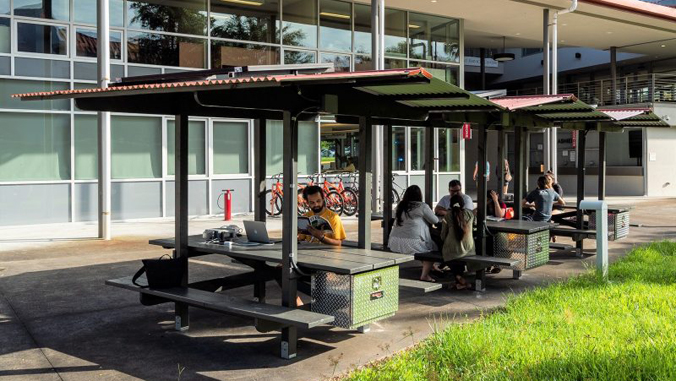
The University of Hawaiʻi at Hilo built several solar-powered charging stations over the summer complete with seating, USB ports, wi-fi access and a unique roof and gutter system to keep students dry during Hilo’s rainy weather.
The projects were completed through a collaboration between the Hawaiʻi Community College carpentry program and the UH Hilo’s administrative affairs team.
Cost efficiency was key for the project to fit within the allocated summer project budget. Hawaiʻi CC carpentry students prepared and installed the concrete pads for the shelters and then constructed the 10 picnic tables. UH Hilo’s information technology specialists designed the solar infrastructure to charge electronic devices and installed wi-fi access points at each of the stations.
The team, which included UH Hilo’s Dave Baptiste and Shannon Asejo and Hawaiʻi CC’s Gene Harada and Darryl Vierra and the Hawaiʻi CC carpentry students, built and installed the tables at a fraction of the cost of purchasing and shipping tables with solar-powered charging stations to Hawaiʻi. The estimate to ship a 4-seat solar powered charging station table to Hawaiʻi was $17,946 per table. The material and supply cost to construct the 8-seat (or wheelchair accessible 6-seat) wood picnic table with a metal roof and gutter was $2,592 per table and extra solar panels from a previous project were used to keep costs down. The projects were initiated by Interim Vice Chancellor for Administrative Affairs Kalei Rapoza and Interim Chancellor Marcia Sakai.
The design of the stations includes solar panels mounted on the roofs to produce efficient renewable solar energy stored in a battery until students access the USB ports and outlets to charge electronic devices. A timing mechanism conserves the stored solar energy when the ports and outlets are not in use. The timer activates the USB ports and 110V outlets in 30-minute intervals to charge electronic devices and can be reactivated for subsequent 30-minute intervals.
The stations are in response to student requests for more covered outdoor spaces to sit, eat, talk story and study.
To read the full story go to UH Hilo Stories.
—By Susan Enright

